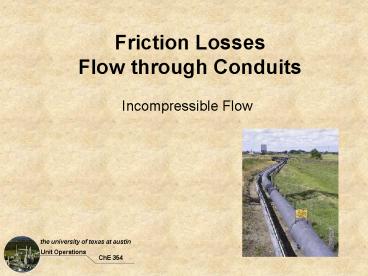Friction Losses Flow through Conduits PowerPoint PPT Presentation
1 / 26
Title: Friction Losses Flow through Conduits
1
Friction LossesFlow through Conduits
- Incompressible Flow
2
Goals
- Calculate frictional losses for laminar and
turbulent flow through circular and non-circular
pipes - Define the friction factor in terms of flow
properties - Calculate the friction factor for laminar and
turbulent flow - Define and calculate the Reynolds number for
different flow situations - Derive the Hagen-Poiseuille equation
3
Shear Stress
When the lower plate is in motion, a force F is
required to maintain the velocity V. This is
because viscous forces in the fluid resists the
deformation arising from the change in velocity
with respect to y.
4
Shear Stress
This give us Newtons Law of viscosity
- ? is the strain rate
- t is a force per unit area
5
Flow Through Circular Conduits
Consider the steady flow of a fluid of constant
density in fully developed flow through a
horizontal pipe and visualize a disk of fluid of
radius r and length dL moving as a free body.
Since the fluid posses a viscosity, a shear force
opposing the flow will exist at the edge of the
disk
6
Balances
Mass Balance
?
Momentum Balance
7
Momentum Balance (contd)
If we imagine that the fluid disk extends to the
wall, Fw is just due to the shear stress tw
acting over the length of the disk.
Equating and solving for ?p over a length of pipe
L.
8
Mechanical Energy Balance
9
Viscous Dissipation (Frictional Loss) Equation
Combining the Momentum and MEB results
- Applies to laminar or turbulent flow
- Good for Newtonian or Non-Newtonian fluids
- Only good for friction losses as result of wall
shear. Not proper for fittings, expansions, etc.
10
The Friction Factor
tw is not conveniently determined so the
dimensionless friction factor is introduced into
the equations.
11
Friction Factor
- Increases with length
- Decreases with diameter
- Only need L, D, V and f to get friction loss
- Valid for both laminar and turbulent flow
- Valid for Newtonian and Non-Newtonian fluids
12
Calculation of f for Laminar Flow
First we need the velocity profile for laminar
flow in a pipe. Well rely on BSL for that
result.
Recall our earlier result
13
Laminar Flow
Find Bulk Velocity (measurable quantity).
14
Laminar Flow
- Laminar Flow
- Newtonian Fluid
15
Hagen-Poiseuille
Recall again
Use Measurement of viscosity by measuring ?p and
q through a tube of known D and L.
16
Turbulent Flow
When flow is turbulent, the viscous dissipation
effects cannot be derived explicitly as in
laminar flow, but the following relation is still
valid.
The problem is that we cant write a closed form
solution for the friction factor f. Must use
correlations based on experimental data.
17
Friction FactorTurbulent Flow
For turbulent flow f f( Re , k/D ) where k is
the roughness of the pipe wall.
Material Roughness, kinches
Cast Iron 0.01
Galvanized Steel 0.006
Commercial SteelWrought Iron 0.0018
Drawn Tubing 0.00006
Note, roughness is not dimensionless. Here, the
roughness is reported in inches. MSH gives values
in feet.
18
How Does k/D Affect f?
19
Friction FactorTurbulent Flow
As and alternative to Moody Chart use Churchills
correlation
20
Friction FactorTurbulent Flow
A less accurate but sometimes useful correlation
for estimates is the Colebrook equation. It is
independent of velocity or flow rate, instead
depending on a combined dimensionless quantity
21
Flow Through Non-Circular Conduits
Rather than resort to deriving new correlations
for the friction factor, an approximation is
developed for an equivalent diameter Deq with
which to calculate the Reynolds number and the
friction factor.
- where
- RH hydraulic radius
- S cross-sectional area
- Lp wetted perimeter
Note Do not use Deq to calculate
cross-sectional area or for laminar flow
situations.
22
Examples
Circular Pipe
Rectangular Ducts
How About Concentric Pipes?
23
Example
Water flows at a rate of 600 gal/min through 400
feet of 5 in. diameter cast-iron pipe. Find the
average (bulk) velocity and the pressure drop.
24
I. Unknown Driving Force
- Calculate Reynolds Number
- Calculate k/D
- Determine f from Moody chart or correlation
- Find hf
- Calculate necessary driving force W, ?p, ?z
25
II. Unknown Flow Rate
Known DF, m, r, D, L, k
Unknown Q(V)
First cancel unknown Q with
- Calculate fRe2.
- Use the Colebrook equation to get f. This
assumes flow is turbulent. - Get Re from results of step 1 and 2
- Use Moody diagram with Re and k/D to get f
- Repeat until f doesnt change
- Calculate Qp D m Re / 4 r
26
III. Unknown Diameter
Known DF, Q(V), m, r, L, k
Unknown D
- Calculate f Re5 from known parameters
- Guess f0.005
- Calculate Re from value obtained in step 1
- Get D from Re
- Calculate k/D
- Use Moody chart to get f and compare to that
assumed - Repeat steps 3 through 7 until f agrees.

